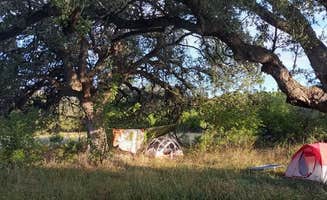Primitive camping near Kyle, Texas centers primarily around the Lake Georgetown area with multiple trail access points and designated backcountry zones. The San Gabriel River Trail system spans rocky limestone terrain with elevation changes of 100-300 feet throughout the route. Primitive sites require self-sufficiency as most locations lack facilities and necessitate proper preparation for varying seasonal conditions.
What to do
Trail exploration: Hike sections of the 26.2-mile San Gabriel River Trail, accessing Sawyer Park Primitive Campsites from multiple entry points. One camper shared their experience: "We ended up not following our AllTrails after a fork in the road heading towards the campsite, and were pretty pooped so decided to camp there off Sawyer Campsite Rd. People had clearly used the shore as a campsite before as there was a makeshift fire pit and some cleared areas for tents."
Water activities: Set up camp near Lake Georgetown's shoreline for swimming and paddling access. Visitors to Walnut Springs Primitive Campground have various arrival methods: "There was a backpacking group, a group of people who canoed in, and ourselves." The lake provides cooling relief during hot Texas summers.
Overnight backpacking: Complete the full loop trail over multiple days, using designated primitive sites as overnight stops. The terrain varies considerably with approximately 40% tree coverage and multiple water crossings, making for a challenging but rewarding multi-day adventure.
What campers like
Solitude during weekdays: Primitive sites typically see fewer visitors Monday through Thursday, offering more privacy and quiet camping experiences. The area provides opportunities for solitude away from more developed campgrounds.
Accessible backpacking: San Gabriel River Trail offers relatively accessible terrain compared to more remote wilderness areas, making it suitable for intermediate backpackers. As one visitor noted, "The trail is getting more and more popular with backpackers, so it is likely that you may see others on the trail."
Natural campsites: The primitive areas feature both established tent pads and open zones for flexible camping setups. At Walnut Springs, campers appreciate the "Large open area; four fire pits, four lamp hangers, four picnic tables, trees closer the trail and grassy areas closer to the water."
What you should know
Prepare for self-sufficiency: No facilities exist at primitive sites, requiring proper preparation. As one camper advised, "No amenities; be prepared to dig cat hole, if drinking lake water be prepared to filter and sterilize."
Weather considerations: Central Texas conditions can change rapidly, especially during spring and fall. Campers should pack appropriate gear for possible temperature fluctuations and precipitation. One camper reported successfully weathering a thunderstorm at Walnut Springs.
Access planning: Different primitive camping areas require different approaches. For example, Walnut Springs "Can be biked in from camp Tejas four miles away or can hiking from Russell Park 2 mi away."
Tips for camping with families
Start with shorter routes: For families with children, consider accessing Walnut Springs Primitive Campground via the shorter 2-mile hike from Russell Park rather than attempting the full loop trail.
Water considerations: During summer months, carry additional water beyond the recommended 2 liters per person. Children typically need more frequent hydration breaks, especially on exposed trail sections.
Timing strategies: Plan family primitive camping trips during spring or fall when temperatures are milder. Early morning hiking followed by afternoon camp setup works well with children's energy levels.
Tips from RVers
Base camp approach: RVers can use developed campgrounds as base camps, then day hike or backpack to primitive sites. Park at trailheads near Cedar Breaks or Tejas Campground to access the trail system.
Gear transportation: Consider using backpacking gear rather than traditional car camping equipment when hiking to primitive sites. Lightweight, compact gear will make the trek more manageable, especially when carrying supplies for multiple people.
Parking notification: When leaving vehicles at trailheads, leave contact information visible. One visitor recommends: "It is good to advise one of the park attendants that you will be hiking or place a note inside your car that you are hiking."


